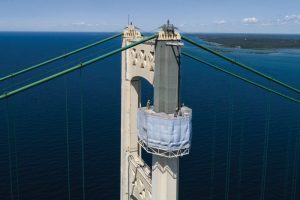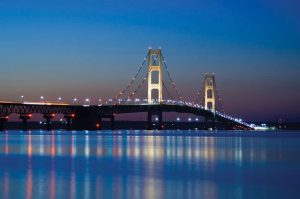The Mackinac Bridge or “Mighty Mac” is a 5-mile-long suspension bridge that connects Michigan’s Upper and Lower Peninsulas. The bridge crosses the Straits of Mackinac, the waterway connecting Lake Huron and Lake Michigan. It opened in 1957 and is the third-longest suspension bridge in the world – the longest in the Western Hemisphere.
A repainting job is no small undertaking and requires significant planning, as might be expected with a bridge of this age, size, and location. The two towers from which the 8,614-foot-long suspension portion of the bridge hangs are 552 feet in height. As part of the bridge’s repainting project, Ruby + Associate’s team was tasked with designing platforms to enable a team to remove and collect the original lead-based paint and repaint the bridge’s towers with a new zinc-based paint. In addition to serving as SER, Ruby provided erection engineering, construction engineering, heavy lift engineering, and steel and aluminum fabrication detailing services to complete the project.
Creativity of Structural Design
Without any precedent of similar systems, the platforms were custom designed and built for painting crews to move up and down the bridge’s towers above the roadway deck, to strip and repaint the bridge’s north and south towers in phases. The platforms encircle the tower legs and allow workers to adjust to accommodate the towers’ tapering with another platform allowing access to struts.
The system needed to be enclosed to allow workers to sandblast and paint a complete section during a work shift to maximize efficiency. The resulting design was a lightweight, two-story movable steel and aluminum platform system that encircles the tower’s leg. Typically, bridge painting projects require scaffolding. The environmentally responsible and innovative platform design eliminated the need for almost 400 feet of scaffolding, resulting in significant savings in materials, material transportation, and labor.
Constructability Solutions
“It’s not like building something at ground level. At every step of the process, we had to ask ourselves, how do you actually carry, connect, tighten or build this 500 feet in the air?” said Project Manager Andrew Twarek, P.E., S.E. “The outriggers had to be made of light aluminum pieces that would fit within the tower’s tiny elevator and could be bolted together at the top of the bridge. Those could then be used to hoist larger pieces,” he added.

The system itself is 24 feet tall, comprised of two rigid aluminum platforms, attached to the outriggers by four separate traction hoists. The contractor had previously selected and purchased the 5800-pound rated capacity hoists, so the platform weight was limited. The platform was designed to be pre-assembled and erected into place in two sections and is formed from 4-foot-deep by 4-foot-wide “C” shaped steel box trusses. They encircle three sides of a tower leg and support a two-story-tall aluminum upper works. The two ends of the “C” truss are attached to each other with cabling so that, in plan, the system resembles a “D” during painting operations. The upper work surface is made of grating to allow sand and paint particles to fall to the bottom platform for vacuum extraction, centralizing the debris gathering process. Canvas walls ensure that debris is contained, and both blasting and painting work can be performed in high winds, regularly exceeding 100 mph at the top of the towers.
Unique Challenges and Complex Criteria
“Another complexity was designing for these anticipated wind loads,” said Bruce Burt, P.E., V.P. of engineering with Ruby, and Principal in Charge. “The 40-foot canvas shrouds that contain the blasting sand and paint act as a giant sail, and wind loads are magnified 500 feet above the water. We designed the platform as a lightweight space frame and incorporated spring-loaded guide rollers to limit side movements during climbing operations.”
A strut platform with its own dual 4-foot-deep steel box truss is used to work on the tower’s struts. The platforms are tied together with hinged sway frames that swing out of the way to allow the platforms to pass by the tower struts as they travel vertically up the tower.
A davit-like “outrigger” system mounted to the top of the tower supports the platforms, which raise and lower using traveling hoists and cables to allow painting the upper 320 ft of the towers. The outriggers are transported in sections to the top of the tower using a tiny existing elevator that barely accommodates three people.

“As this [was] the first time in the bridge’s history when the towers have been stripped to bare metal and repainted, it makes sense that the team would need new, innovative equipment to get the job done,” said Mackinac Bridge Authority Chief Engineer Kim Nowack, P.E. “We… thank them for their work preserving this infrastructure icon.”■
Ruby + Associates, Inc was an Outstanding Award Winner for the Mackinac Bridge Paint Platforms project in the 2020 Annual Excellence in Structural Engineering Awards Program in the Category – Other Structures.
